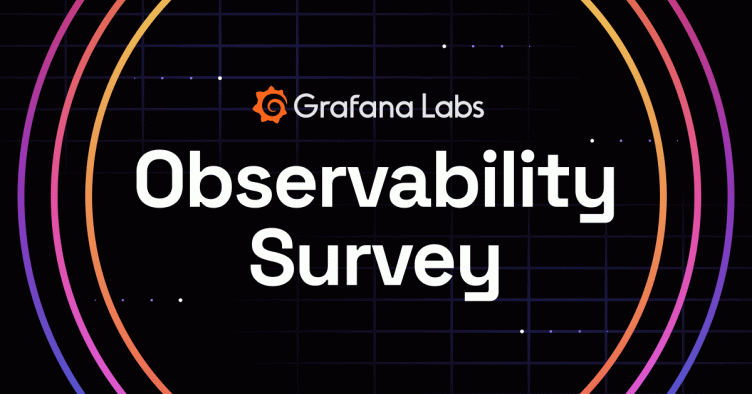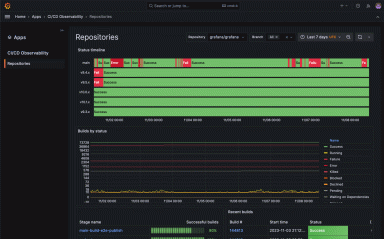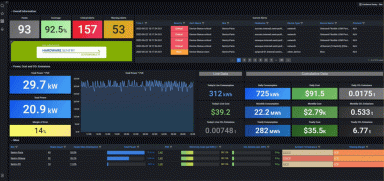
Get an early look at the 2024 Grafana Labs Observability Survey, and weigh in before it's too late
Note: The survey is now closed. Check out the Grafana Labs Observability Survey 2024 today to see the final report.
The holiday season is in full swing, and so is the second annual Grafana Labs Observability Survey. And while there’s still time to make your voice heard, we want to give you a sneak peek at what the Grafana community has to say as you start to wind down your 2023.
We’ve received a ton of great input since we launched the survey in September. Here are some of the highlights from the early returns:
- There’s no shortage of observability tools and data sources. 95% of respondents say they’re using multiple observability technologies in their individual groups, with more than a third using at least six. Among Grafana users, more than half have at least six data sources configured and actively in use.
- A centralized view can make all the difference. A growing number of organizations are centralizing observability, and the vast majority (80%) have saved time or money as a result.
- Observability is maturing — and expanding. Organizations are far more likely to have proactive observability strategies than reactive ones, but only a small percentage (16%) have instituted a systematic approach. Meanwhile, newer practices like SLOs and eBPF are seeing big spikes in interest.
- Maybe the O in O11y should stand for OSS. Four of the five most popular observability technologies in our survey are open source, and more than half of respondents said they’re using Prometheus and OpenTelemetry more than they did last year.
Continue reading to learn more about these early results. And while they provide a great window into the state of observability, we’re hoping to get even more input before the end of the year, so please take the brief, anonymous survey if you haven’t already.
So many tools, so many sources
Observability works best when organizations get the right signals from their apps and infrastructure, and those signals can come from metrics, logs, traces, profiles, and more. So it should come as no surprise that the vast majority of respondents say their teams use multiple observability technologies.
Within their groups, 59% of respondents use between two and five observability technologies, while another 36% use six or more. But those tools aren’t used uniformly across groups, as half of the respondents said their company uses at least six observability tools, including 16% that are using between 11 and 50. And that high-end number is even higher among Grafana users, with 29% having more than 10 data sources configured and actively in use.
Taking a step back, it’s clear that companies are awash in tooling, with respondents collectively citing more than 50 different observability technologies that they currently use.
Prometheus, OpenTelemetry continue to rise
The respondents clearly lean toward OSS for observability, with 73% saying they mostly or only use open source, and another 17% saying they’re roughly split between commercial and OSS licenses.
And OSS adoption appears to be on the rise, with more than half of respondents saying they’ve increased their usage of OpenTelemetry and Prometheus compared to last year. Of the two projects, Prometheus is further along in adoption, with 74% saying they use it in some capacity, and another 17% investigating it. That usage figure drops to 40% for OTel, with another 47% investigating it.
The many benefits of consolidation
Having a consolidated view of all those tools and technologies tends to save time and money. Among all respondents so far, 80% say they have centralized observability. And among that group, 78% have saved time or money as a result.
When asked for more details about these savings, the most commonly cited benefit was improvements in mean time to repair (MTTR), but others called out additional day-to-day benefits, such as a “reduction in overhead for teams, streamlined processes, and communications.” Some cited improvements to their overhead, including one respondent who said, “It’s allowed us to spot over-utilization, which was leading to both extra cost, but more importantly, instability.”
Companies are also seeing benefits from correlating their observability data, with the most frequently cited examples being resource efficiency, capacity planning, UX improvements, and cost control.
A maturing market
Observability is no longer in its infancy, but it’s clearly still an evolving space. Ideally, an organization has a systematic approach to observability, with procedures and tools in place throughout the software development life cycle in order to address issues before users know about them. However, only 16% of respondents said they’ve reached that level of maturity. Conversely, 23% say their organizations are still reactive, with their customers discovering problems before they do.
Meanwhile, organizations are expanding their observability use cases. The majority of respondents said they’re investigating or actively using application observability, eBPF, SLOs, as well as observing microservices and supply chain security. SLOs and application observability saw the biggest spike in interest, with nearly half of respondents saying both are more relevant than last year.
Take the survey today
That’s a lot to chew on, and there will be plenty more in the new year when we release the full report, including insights on the potential role of AI in observability. But keep in mind: These figures aren’t finalized. We’d love to be as representative of our community as possible, so the more people that take five minutes (Really, it’s that quick!) to fill it out, the better our results will be. So please help us out and take the survey today.



